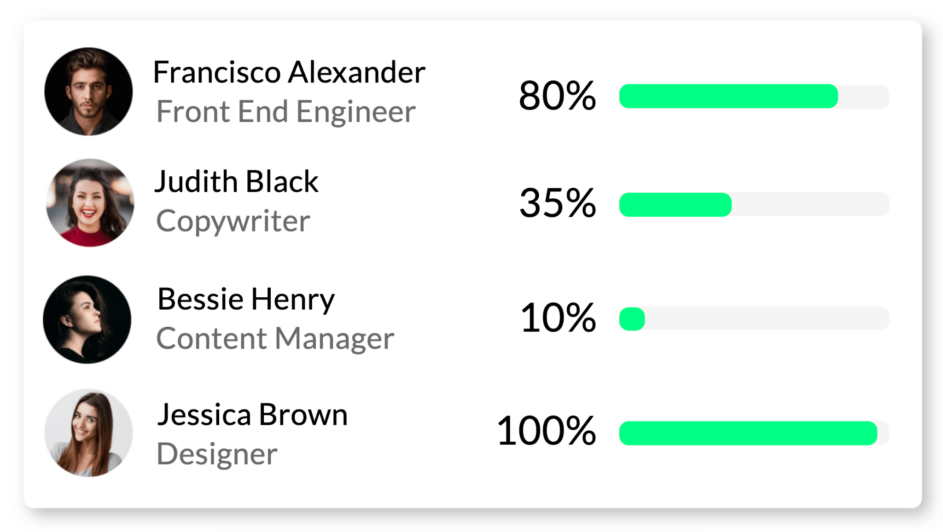Project manager or not, chances are you’ve heard the phrase, “you can’t manage what you don’t measure.” But even if you fully understand the need to track project data, it can still be tough to determine which project manager performance metrics you should be looking at.
If you get caught in the trap of just using broad categories like “budget” to evaluate how a project is doing (or did), it’s hard to nail down the specifics of what’s going right or wrong. And without these detailed insights, you’re left relying on guesswork to identify project problems and solutions.
By using more granular project management metrics, you can objectively analyze what’s working (or isn’t) across projects. That’s why we’ve put together a list of performance metrics to track. Let’s dive in.
In this article 📖
Getting started with project manager performance metrics
Every project is different, and as such, you’ll use a slightly different set of metrics for each. But there’s a handful of core project manager performance metrics you’ll always want to keep an eye on to hold yourself accountable and ensure project success.
These foundational data points will give you a clear picture of project performance and help you make proactive improvements throughout the project’s life cycle. First up? Cost variance.
1. Cost variance
What it is: Cost variance is the difference between your earned value (planned budget) and actual project costs.
Why you should measure it: Tracking cost variance throughout your project life cycle will show you exactly when you’re over or under budget. If you’re over (a negative cost variance), you can take steps to remedy the situation in advance, preventing the nightmare of asking clients for more money. If you’re under budget (a positive cost variance), you can double-check no compromises were made in quality.
How to measure it: Budgeted cost of work – Actual cost of work = Cost variance
2. Gross profit margin
What it is: Gross profit margin is a ratio indicating how much money your company made from a project in relation to how much it spent on the project.
Why you should measure it: On its own, project profit doesn’t factor in how much money your company had to spend to make that new revenue. This can be misleading when it comes to measuring financial performance. By tracking your gross profit margin, you can objectively determine which projects (and clients) are worth the cost of doing business. The higher the gross profit margin, the stronger the return on investment (ROI) is.
How to measure it: (Revenue – Project expenses) ÷ (Revenue × 100) = Gross profit margin
Pro tip: If you’re new to creating project budgets, try our free project budget template.

Get your free project budget template.
3. Cycle time
What it is: Cycle time is the length of time it takes to complete a task, sprint, or project.
Why you need it: Tracking the time it takes to complete different project milestones and the project as a whole gives you hard data for your future project plans. By rooting your timelines in reality and not educated guesses, you can optimize your team’s time and establish deadlines that they and your clients find reasonable.
How to measure it: End date – Start date = Cycle time
4. On-time deliveries
What it is: When you measure on-time deliveries, you’re looking at the percentage of timely work delivered in comparison to work delivered past the original deadline.
Why you need it: How often deadlines are being met or missed are critical predictors of project success and client satisfaction. Additionally, tracking exactly which tasks miss the mark and who’s assigned to each will help you identify recurring patterns.
For example, if four out of five delayed tasks were from one team member, it’s a sign to check in and see how you can offer support to resolve any roadblocks. You may consider temporarily reducing the workload of a burnt-out team member or giving them a chance to explore a new type of assignment that aligns with their interests. Or if all five tasks were, say, a specific type of coding, that’s an indication that your team will need more time to complete those tasks in the future.
How to measure it: (Tasks delivered on time ÷ Total number of tasks) × 100 = % of on-time deliveries
5. Project scope creep
What it is: Project scope creep is measured as a percentage of change in the original scope of work.
Why you need it: The more unplanned work that gets added to your existing project timeline, the greater the likelihood of having to compromise on some portion of your iron triangle. If you don’t monitor scope creep and blindly say “yes” to every new client ask, your workers will burn out, and your project is actually more likely to fail.
Consistently reviewing scope creep helps you protect your team’s time and energy and lets you know when you need to have a conversation with your client to set more reasonable expectations.
How to measure it: (Unplanned work tasks ÷ Planned work tasks) × 100 = % of scope creep
6. Individual and team utilization rates
What they are: Utilization rate is the percentage of team members’ time spent working in relation to their availability.
Why you need them: Optimal resource utilization is key to project success or failure. Overbook your employees, and watch deliverable quality decrease as burnout shoots up. Give them too little work, and you’re missing out on opportunities to deliver faster. If utilization rates dip below or exceed 70-80% throughout your project, you know it’s time to rebalance workloads.
How to measure them:
- Individual utilization rate = (Total working hours ÷ Total hours available) × 100
- Team utilization rate = (Total individual utilization rates ÷ Total number of employees) × 100
Check out our post on resource utilization for more information on calculating target rates.

Get a complete overview of resource utilization with Resource Guru.
7. Client satisfaction
What it is: Client satisfaction is a numeric score indicating how happy or unhappy your client was with the project process and results.
Why you need it: Just because you think your team did a stellar job doesn’t mean the client feels the same way. You can’t fix something if you don’t know about it, which is why it’s important to check in with clients at the end of each project to see if they were satisfied or not. If they’re happy, keep doing what you’re doing, but if not, you can have a conversation about what could’ve been done to better meet their needs.
This creates stronger working relationships and gives you a clearer picture of what needs to happen internally moving forward to meet client expectations and garner consistent revenue.
How to measure it: Send a survey at the end of each project asking clients to rank their overall satisfaction on a scale of 1-5. To get more granular, include specific categories like “communication” or “deliverable quality.”
3 tips for selecting additional metrics to monitor
Once you get the hang of measuring foundational project manager performance metrics, you may find that you want to dive even deeper. However, you don’t want to just select random data points to measure and hope for the best.
These three tips will help you thoughtfully select new, relevant metrics that broaden your understanding of project performance while aligning with your unique business priorities.
1. Review your iron triangle
Key performance indicators (KPIs) are designed to help you better balance your project budget, scope, and time. If you notice you’re dealing with continual issues in one of these key areas, that’s the first place you should start digging into with extra metrics. For instance, if your team is constantly playing catch-up, you might consider tracking schedule variances so you can immediately identify when things are falling behind (and with whom).
2. Select project management performance metrics that support your industry’s unique needs
Make a list of industry-specific tasks or categories that you’d benefit from having more quantifiable data on. While the foundation of a project manager role is the same across industries, different types of PMs manage different project success factors.
So, a technical project manager will likely need to track metrics on aspects that, say, a construction manager would have no use for—think missed software bugs, average software failure rates, and the timing of security update releases.
3. Ask your project team members for input
Since project performance metrics give insight into team performance, it’s helpful to get feedback from your employees on which KPIs they’d like to see tracked. This facilitates greater ownership in these areas.
For instance, if your team is expected to complete a certain number of deliverables every month, they might ask for clear visibility into their 3-month rolling average to see how they’re doing.
Track project manager performance metrics in a single source of truth
Tracking and reporting on key PM analytics help you improve projects while also helping you prove your objective value as a project manager and leader. But it’s harder to maintain accurate data when analytics are scattered across platforms—especially as you start adding more project manager performance metrics into the mix.
Prevent errors and streamline your data collection and reporting process with automated project management software. With less manual effort (and math), fewer inaccuracies, and fewer headaches, you can focus on strategically analyzing metrics and coming up with effective solutions to project problems.
Try our free 30-day trial to see your most important metrics such as availability, utilization, and scheduled time in one tool with Resource Guru.




